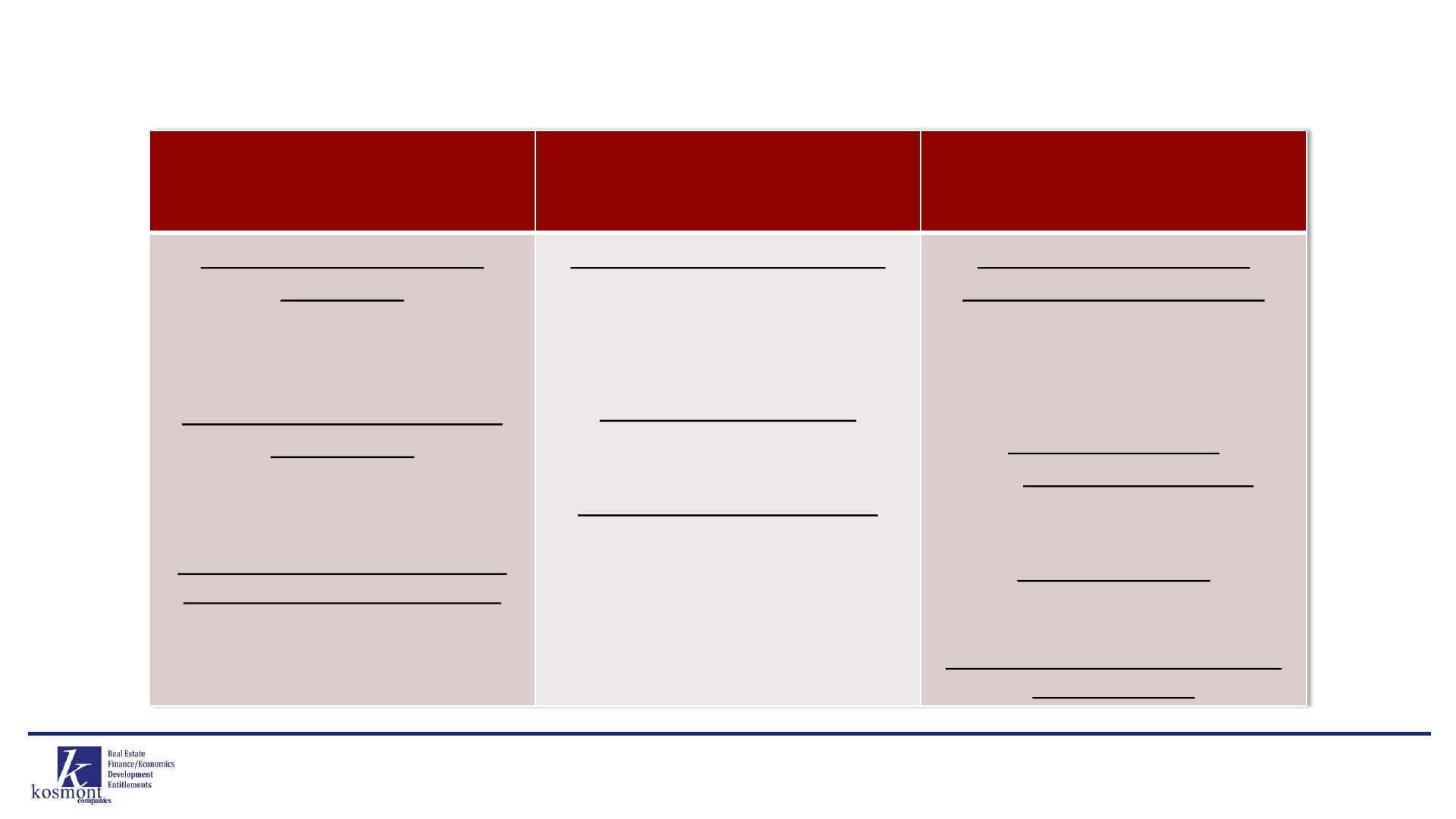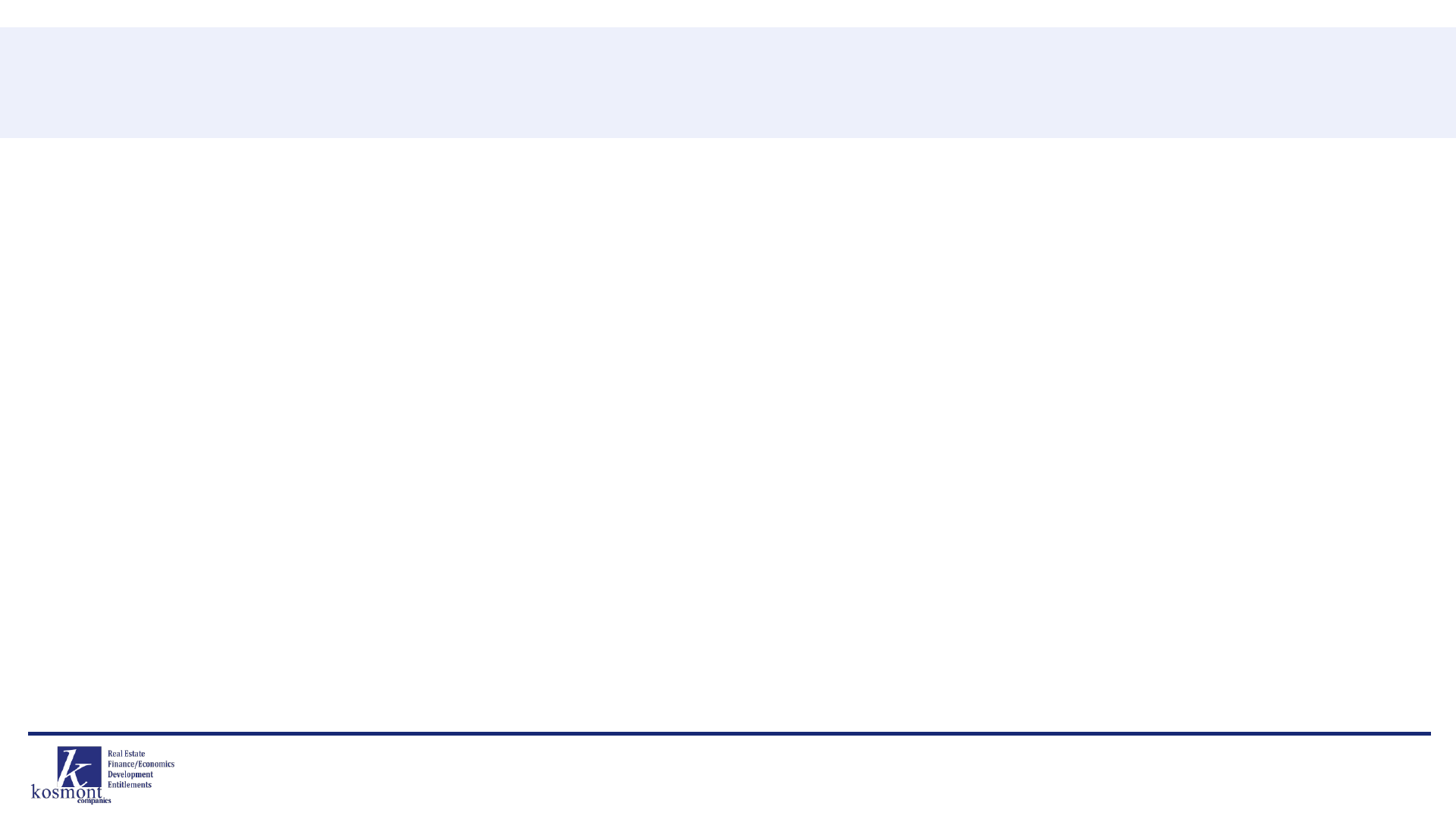
League of California Cities
Planning Commissioners Academy
March 2023

What is the Surplus Land Act?
The Surplus Land Act (SLA), originally enacted in 1968, was modified in 2020 (AB1486), to
ensure availability of property for affordable housing development.
Under the new SLA structure, public agencies that want to sell or lease a property must go
through a structured sale disposition process that first requires exposing the property to a
state published list of affordable housing developers and other interested parties.
Proprietary
Do Not Duplicate
Without Authorization
2

Communities at Crossroads:
An Opportunity to Use Surplus Properties for a Vital Future
Private sector investor momentum has shifted, and consumer preferences have changed.
The post-COVID economy is a new world – retail is rightsizing from e-commerce, the office
market is sideways from telework, industrial is booming, and housing is in high demand.
The housing shortage has led to an avalanche of state policy requirements imposing density,
zoning standards, and redirecting the disposition of local public agency owned real estate
(aka…Surplus Land Act).
Beyond SLA compliance, cities have a timely opportunity to review their property portfolio,
leverage private sector momentum, and advance their community’s objectives for
economic development, resiliency, and housing.
Proprietary
Do Not Duplicate
Without Authorization
3

What is the Reconfigured Economy?
4
The New Consumer / Investor / Policymaker Mindset.
Consumers driven by quality of
life, cost of living and housing,
amenities, essentials, and experiences
Want it all in a 15
-
Minute Community
Investors driven by new
technology, shifting demand,
supply chain anomalies, and
new live / work patterns
Seeking value from new demand drivers
City Hall driven by resident and
employer needs & new state policies
which seek to install housing
Tension: Comply with state priorities
vs. achieving community priorities in a
post covid digital world
(RHNA, Density Bonus, SLA)
Proprietary
Do Not Duplicate
Without Authorization

Housing is Not a Loss
Leader, it’s a Growth
Driver
Retail is Not
Just
Retail
Anymore
Telework is
Reconfiguring Office
Industrial / Distribution
is Critical for Your
Economy
Housing Creation as
Economic Development
Retail Reimagination as
Economic Development
Office Conversions as
Economic Development
Industrial & Fulfillment as
Economic Development
•
New housing can generate
significant new tax revenues and
support local jobs
•
Housing is not necessarily a net
negative fiscal impact, especially
at current property values
•
US over-built on retail; ~25% of
U.S. malls may close over next 5
years; COVID accelerated reuse
•
Blended/mixed use projects
integrate multiple uses (
housing,
retail, open space, office, hotel)
onto one site
•
Telework and work from home
options are reshaping needs for
office space & business districts
• Job redistribution tied to housing
•
Vacancies can lead to reduced
assessments and fiscal pressure
•
Modern industrial is not “your
father’s industrial” – not
smokestacks
•
Retail won't thrive without
distribution
•
Booming demand for
distribution, e-commerce, and
data centers, blending for
fulfillment/delivery, job creators
Key Land Use Trends for Economic Development
5
Proprietary
Do Not Duplicate
Without Authorization

Public Sector Perspectives
6
State Policy Land Use
Economic Development
State focused on housing
production
especially in high-demand job
centers and TOD
New focus on housing policy
enforcement
RHNA, Density Bonuses/HAA and
SLA pressure cities to deliver homes
SLA targets public agency owned
property for affordable housing
Land use demands blending
retail centers w/ apartments;
office conversions to residential;
infill distribution for delivery
Flexible zoning needed
for new integration
Rethinking outdoor spaces
parks, green space, outdoor
commercial, pedestrian
orientation,
entertainment, pop-up venues
Cities can’t just focus on
attracting large employers
make places with amenities,
experiences, and housing that
attracts workers
Attracting workers
and attractive housing is
as essential as job creation
Strategy Matters
leveraging own resources and
attracting state / local funds
Get ahead of the SLA by updating
your asset plans
Proprietary
Do Not Duplicate
Without Authorization

Surplus Land Act (SLA) Overview
Origin
In a response to the massive Statewide housing shortage, State Legislature passed
dozens
of housing bills including AB 1486 (Surplus Land Act) to address this crisis.
Purpose
The SLA gives affordable housing developers a right of first refusal on all public agency
owned land in the State of California
. Does not necessarily prevent agencies from
ultimately selling or leasing property for other uses or fair market value.
Mandate
Public Agencies in California (e.g., cities, counties, special districts, school districts, etc.),
with certain exceptions, must follow this mandate prior to
selling or leasing any public
agency owned real estate.
Process
The SLA requires an up to 180
-day request for proposal/bid process to either select or
reject an affordable housing project/proposals. Once rejected, the property can be sold
or leased to broader market.
7
Proprietary
Do Not Duplicate
Without Authorization

New World of Surplus Land Act Requirements
The Old Days:
Want to sell / lease a City property? Just put out an RFP/Q
The New World Order:
The SLA requires public agencies to first go through a process
of offering property to affordable housing developers before
pursuing other opportunities.
Opportunity:
Public agencies should look at SLA as a “Value Capture”
Opportunity to more efficiently use public properties:
• Performance-based leases / ground leases
• Monetizing assets (such as civic centers, parking garages, etc.)
• Selling property to private sector – includes lease-back
strategies, continued operation of existing use, redevelopment
into new uses
8
Proprietary
Do Not Duplicate
Without Authorization
HEADLINES
“Let’s Tap the Breaks.” San Diego Not Ready to
Solicit Bids to Redo City Hall Complex
San Diego Union-Tribune, 1/9/23
[Santa Monica] Takes First Step Toward Offering
Lease on Civic Auditorium, Other Site
Santa Monica Daily Press, 10/20/22
555 New Apartments Planned for South
Natomas as Sacramento Sells Land to Developer
Sac Bee, 1/25/22

The Primary SLA Questions
What are they worth?
What is the highest and best use?
What properties do you have?
9
Proprietary
Do Not Duplicate
Without Authorization
Do you want housing on these properties?
Do you want to use them for other purposes?
Public Use? Commercial Use? Special Conditions?
Is there an adjacent owner who wants the property?

The Big Question: What’s in Your City’s Property Garage?
10
Proprietary
Do Not Duplicate
Without Authorization
Civic Center/
Downtown Site(s)
Former RDA
sites
Parking Lot &
Structure(s)
Remnant
Lots/ROWs
And…what will it take to Get A Garage Sale Permit?

First, is Your Property Exempt?
11
Proprietary
Do Not Duplicate
Without Authorization
Property can be declared “exempt surplus” if it falls under a few categories:
• “Grandfathered” Land – if City had agreement (e.g., ENA) in place prior to 9/2019, land
is subject to a pre-AB1486 version of the SLA
• Land Destined for Affordable Housing - at least 75% units restricted for lower
income families, or a mixed-use development with 300+ units and at least 25% restricted for
lower income
• Land Dedicated for Other Public Uses – transferred to another agency or exchanged
for another property for local agency’s use
• Land Not Suitable for Affordable Housing – former street, right-of-way, easement;
small sites (less than 5k SF or less than 10k SF with no recorded accesses); sold to owner of
contiguous land

The SLA Pathway to Affordable Housing
12
Proprietary
Do Not Duplicate
Without Authorization
If Property is not “exempt surplus”, it must go through a noticing process to
affordable housing developers and certain agencies:
• Notice of Availability given to affordable housing developers
• Notice given to local agencies including school districts for school facilities and parks and
recreation districts for open-space use (given priority to other proposals)
• Parties have 60 days to express interest and then provided 90 days to negotiate in good faith
• City does not have to sell the property for less than fair market value
• If agreement on price/terms not reached, then City can sell to other parties (Post HCD Approval)
• Property that completes process is subject to covenant requiring any residential development
w/10 or more units to provide at least 15% of units to lower income households
• Enforcement: If local agency does not comply with SLA, HCD will impose fine of 30% of final sale
price for first violation, 50% of final sale price for second violation

SLA: Steps for Disposition Process
13
Proprietary
Do Not Duplicate
Without Authorization
Step 1
•
City declares property “surplus” or "exempt surplus" land
•
If exempt, then City pursues HCD concurrence by providing written findings
•
If not exempt, then City prepares Notice of Availability (NOA)
Step 2
•
City sends NOA to qualified affordable housing developers & other required public entities for 60 days
Step 3
•
If "Step 2" responses received, 90-day good faith negotiation period commences
•
If no responses received or negotiations at impasse (e.g. FMV), agency may negotiate with other
non-affordable housing developers
•
Process will require HCD approval which can take up to 30 days for a Letter of Compliance
Step 4
•
Post HCD Approval, City may dispose of surplus land without regard to SLA
•
Agency must still record 15% affordability covenant, which is triggered if 10 or more units

Case Studies: SLA Compliance is Unique to Each Public Agency
14
County of Los Angeles
• +/- 200 Acre Property
• Zoning: Heavy Agriculture
• $229M flood risk mitigation, Adjacent to
Detention Center
• SLA Status: Process completed, HCD
certified, property brought to market via RFP
Moorpark Successor Agency
• +/- 1.8 Acre Property
• Zoning: Industrial
• Adjacent to Floodplain, Liquefaction issues
• Pre-Existing Agreement with Developer
• SLA Status: Pre-existing agreement did not
close; property under City review
City of El Cajon
• +/- 20 Acre Property
• Zoning: Commercial, Downtown Master Plan
• Complex Civic Center Revitalization;
County/State owners/users
• Reuse program requires public uses
• SLA Status: City reviewing alternatives
Each Public Agency needs to devise a real estate disposition strategy that considers its own
economic development priorities in light of SLA.
Proprietary
Do Not Duplicate
Without Authorization

Compliance and Strategy:
Key Steps to Successfully Navigate the SLA
Strategy and execution go hand-in-hand with compliance. Cities need to act strategically
and proactively to get the most out of their property assets and advance their goals.
15
1) Know Your Portfolio 2) Know Your Priorities 3) Know Your Strategies
Understanding your agency’s property
portfolio is key
Perform due diligence and prioritize
potential portfolio of properties
contemplated for disposition and/or
development
Consider the variety of economic
development priorities that you can
use your properties to pursue:
•
Housing
•
Civic/Public amenity purposes
•
In conjunction with private projects
•
Other uses
Do you want to keep the property for
public use or put into private service?
Make a strategic determination of
which properties to keep or sell.
Agencies can use a variety of strategies
to increase market/reuse value of its
land & comply with the SLA
Be sure to consider CEQA /
Entitlements & RHNA
Align these property strategies with
other economic development tools /
approaches
Proprietary
Do Not Duplicate
Without Authorization

Primary Steps to SLA Success
1
Property Inventory (Start Early)
Identify priority properties and/or projects now that may be impacted by SLA & can be
put into productive use.
2
Prioritize, Screen, & Select an Approach
Confirm value, SLA applicability, Preferred Disposition Strategy/Use (e.g., asset monetization,
sale or lease, public use, housing, etc.), Econ Dev Tools, & Financing Mechanisms.
3
Implementation (Transparency is Key)
Execute preferred disposition (sale, lease, etc.) strategy that’s done openly & fulfills
community goals and objectives (job creation, tax revenues, housing)
16
Proprietary
Do Not Duplicate
Without Authorization

Surplus Land Act: New Rules for Public Real Estate
17
SLA Here to Stay
New rules being used for property
disposition and housing creation
New Processes
Cities navigating evolving
procedures and compliance
New Strategies
Time to be strategic: use property
assets to pursue priorities
Proprietary
Do Not Duplicate
Without Authorization
Sooner better than later. Cities should start NOW to review/evaluate property portfolio in alignment with econ.
development goals/objectives
SLA is nuanced and circumstantial. Engaging HCD early in process is important to determination of compliance
Transparency is key. Promote the City’s repositioned asset program to community to achieve HCD compliance

What’s Next For SLA? There’s More to Come
1
18
Proprietary
Do Not Duplicate
Without Authorization
Bill
Sponsors
Summary
AB 480
Asm
. Ting
Sen. Umberg
Includes expanding exemptions, administrative process changes for declaring “exempt surplus land”, violation / penalty
changes
AB 457
Asm
. Patterson
Expand definition of “exempt surplus land” to include parcels smaller than 2 acres that are identified for future roadway
development, are zoned / used for retail commercial use, and abut a state highway ROW
AB 837
Asm
. Alvarez
Expands “exempt surplus land” to include land acquired by an agency to develop a university / innovation district in
accordance with a plan (City of Chula Vista)
AB 983
Asm
. Cervantes
Expands “exempt surplus land” to include land that is designated in an adopted downtown revitalization plan (area less
than 1.1 square miles) and includes residential, commercial, office, civic and hospitality uses.
AB 510
Asm
. Jackson
Exempts land placed into a local land trust / disposed out of a local land trust from the disposal requirements of the SLA
SB 747
Sen. Caballero
Administrative process for declaring property as “exempt surplus land”
SB 229
Sen Umberg
Open / public session for local agency to review notice of violation; prohibit agency’s governing body from taking final
action to ratify/approve proposed disposal until a public session is held.
SB 34
Sen. Umberg
Sen. Min
Sen. Newman
Asm
. Quirk-Silva
Asm
. Ting
Makes legislative
findings / declarations as to the necessity of a special statute for Orange County regarding notification
/ violation process
SB 693
Sen.
Seyarto
Exempts specific parcels in the City of Murrieta from the SLA
AB 1734
Asm
. Jones-Sawyer
Changes annual deadline of when cities must provide inventory of surplus land to HCD from April 1
st
to March 1
st

What Needs to Get Done in Your Community?
How do I add housing, comply
with RHNA, & address density?
How do I meet these escalating
state requirements?
How do I fix regional shopping
centers and retail corridors ?
How do I revitalize downtown?
How do I pay for constituent service demands?
Can sale or deployment of Surplus Assets help?
How do I replace sales tax?
How do I meet the needs of today
and prepare for the future?
19
Proprietary
Do Not Duplicate
Without Authorization
